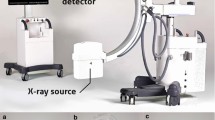Abstract
Purpose
X-ray fluoroscopy guidance is frequently used in medical interventions. Image-guided interventional procedures that employ localization for registration require accurate information about the C-arm’s rotation angle that provides the data externally in real time. Optical, electromagnetic, and image-based pose tracking systems have limited convenience and accuracy. An alternative method to recover C-arm orientation was developed using an accelerometer as tilt sensor.
Methods
The fluoroscopic C-arm’s orientation was estimated using a tri-axial acceleration sensor mounted on the X-ray detector as a tilt sensor. When the C-arm is stationary, the measured acceleration direction corresponds to the gravitational force direction. The accelerometer was calibrated with respect to the C-arm’s rotation along its two axes, using a high-accuracy optical tracker as a reference. The scaling and offset error of the sensor was compensated using polynomial fitting. The system was evaluated on a GE OEC 9800 C-arm. Results obtained by accelerometer, built-in sensor, and image-based tracking were compared, using optical tracking as ground truth data.
Results
The accelerometer-based orientation measurement error for primary angle rotation was \(-0.1\pm 0.0^{\circ }\) and for secondary angle rotation it was \(0.1\pm 0.0^{\circ }\). The built-in sensor orientation measurement error for primary angle rotation was \(-0.1\pm 0.2^{\circ }\), and for secondary angle rotation it was \(0.1\pm 0.2^{\circ }\). The image-based orientation measurement error for primary angle rotation was \(-0.1\pm 1.3^{\circ }\), and for secondary angle rotation it was \(-1.3\pm 0.3^{\circ }\).
Conclusion
The accelerometer provided better results than the built-in sensor and image-based tracking. The accelerometer sensor is small, inexpensive, covers the full rotation range of the C-arm, does not require line of sight, and can be easily installed to any mobile X-ray machine. Therefore, accelerometer tilt sensing is a very promising applicant for orientation angle tracking of C-arm fluoroscopes.










Similar content being viewed by others
Explore related subjects
Discover the latest articles and news from researchers in related subjects, suggested using machine learning.References
Cleary K, Peters TM (2010) Image-guided interventions: technology review and clinical applications. Ann Rev Biomed Eng 12:119–142
Wegner I, Teber D, Hadaschik B, Pahernik S, Hohenfellner M, Meinzer H-P, Huber J (2012) Pitfalls of electromagnetic tracking in clinical routine using multiple or adjacent sensors. Int J Med Robotics Comput Assist Surg. 4 Apr, 2012. doi:10.1002/rcs.1431 [Epub ahead of print]
Jain AK, Mustafa T, Zhou Y, Burdette C, Chirikjian GS, Fichtinger G (2005) FTRAC—a robust fluoroscope tracking fiducial. Med Phys 32(10):3185–3198
Wallner K, Blasko JC, Dattoli M (2001) Prostate brachytherapy made complicated. SmartMedicine Press, Seattle
Dehghan E, Moradi M, Wen X, French D, Lobo J, Morris WJ, Salcudean SE, Fichtinger G (2011) Prostate implant reconstruction from C-arm images with motion-compensated tomosynthesis. Med. Phys. 38(10):5290–5302
Lee J, Labat C, Jain AK, Song DY, Burdette EC, Fichtinger G, Prince JL (2011) REDMAPS: reduced-dimensionality matching for prostate brachytherapy seed reconstruction. IEEE Trans Med Imaging 30:38–45
Grzeda V, Fichtinger G (2010) C-arm rotation encoding with accelerometers. Int J Comput Assist Radiol Surg 5(4):385–391
Lasso A, Heffter T, Pinter C, Ungi T, Chen TK, Boucharin A, Fichtinger G (2001) PLUS: an open-source toolkit for developing ultrasound-guided intervention systems. In: Proceedings 4th NCIGT and NIH, Image Guided Therapy Workshop, Arlington, VA. 4, pp 103
Chintalapani G, Jain AK, Burkhardt DH, Prince JL, Fichtinger G (2008) CTREC: C-arm tracking and reconstruction using elliptic curves. In: IEEE computer society conference on computer vision and pattern recognition workshops, cvprw, pp 1–7
Yao J, Taylor RH, Goldberg RP, Kumar R, Bzostek A, Van Vorhis R, Kazanzides P, Gueziec A (2000) A C-arm fluoroscopy-guided progressive cut refinement strategy using a surgical robot. Comput Aided Surg 5(6):373–390
Acknowledgments
This work was supported through the Applied Cancer Research Unit program of Cancer Care Ontario with funds provided by the Ontario Ministry of Health and Long-Term Care. Gabor Fichtinger was funded as a Cancer Ontario Research Chair. The authors thank Yashar Madjidi for the fabrication of the C-arm calibration phantom.
Conflict of Interest
Thomas Wolff, Andras Lasso, Markus Eblenkamp, Erich Wintermantel and Gabor Fichtinger declare that they have no conflict of interest.
Author information
Authors and Affiliations
Corresponding author
Rights and permissions
About this article
Cite this article
Wolff, T., Lasso, A., Eblenkamp, M. et al. C-arm angle measurement with accelerometer for brachytherapy: an accuracy study. Int J CARS 9, 137–144 (2014). https://doi.org/10.1007/s11548-013-0918-3
Received:
Accepted:
Published:
Issue Date:
DOI: https://doi.org/10.1007/s11548-013-0918-3




